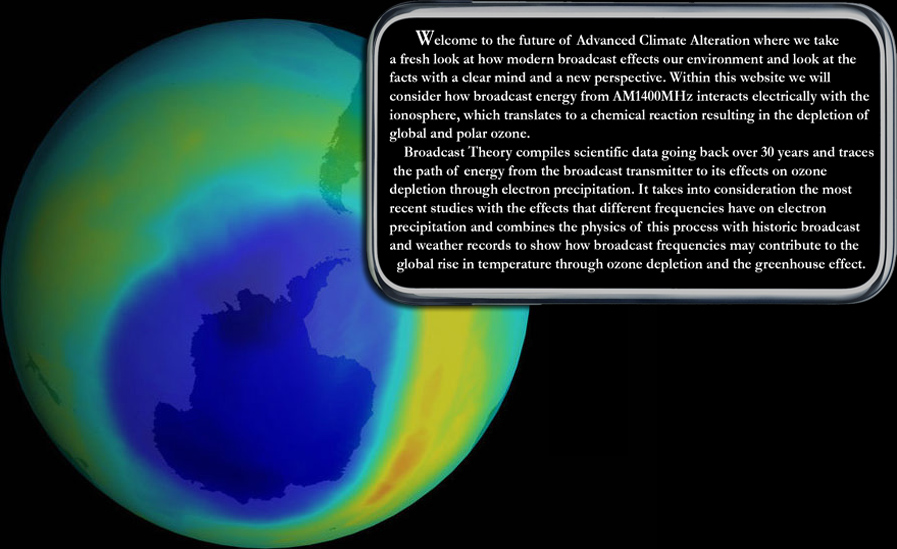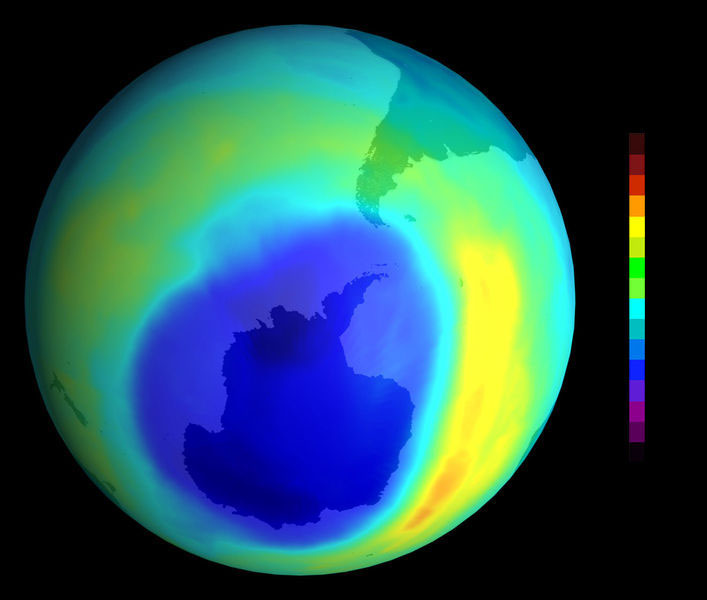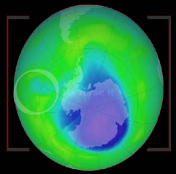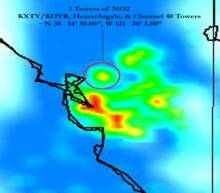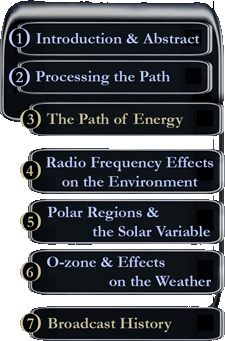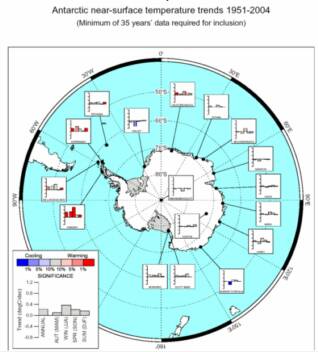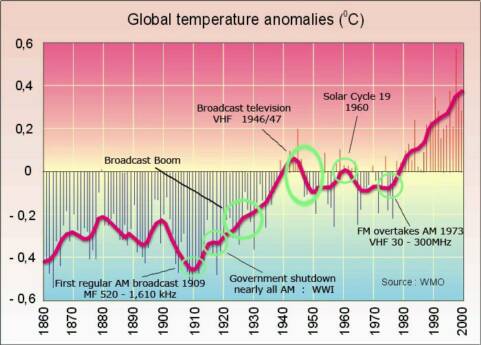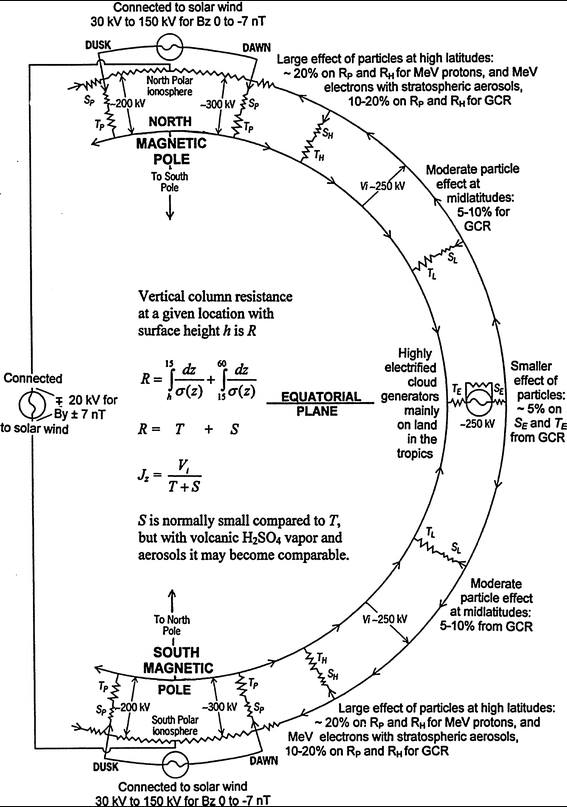Home ~ Learn More
An NO2 signature in the vicinity of 3 broadcast towers in Walnut California has been discovered producing a perfectly round spot of NO2 from outside of the city away from conventional NO2 sources.
...read more
A Revolutionary Perspective on Climate Change
2007 ~ 2019
Research Sections
Dear Colleagues,
Broadcast Theory explores this connection between our historic use of broadcast frequencies and the global climate.
3 Broadcast Towers create NO2 signature in California!
The Tall Tower Report - NO2 Observations from NASA OMI satellite
DEMETER Micro-Satellite ~ CNES France
“The processes in this transition region connect the solar and magnetospheric effects with the atmospheric response which, in fact, determine space weather in the Earth’s environment. This region is also the part of the Earth’s atmosphere where electromagnetic radiation from natural sources such as lightnings, and artificial sources such as radio, TV and radar transmitters, exhibit resonance and other interaction phenomena. The impact of these natural and man-made effects on the Earth’s space environment are of major public concern.” 

...read more
T I P E R - NOx : Transmitter Induced Precipitation of Electron Radiance
can contribute to climate change in 3 ways
1 Direct heating: VLF & AM broadcast band gyrofrequency (630kHz ~ 1.45MHz ~ 1630kHz) creates
ionospheric turbulence causing electron precipitation aka >
2 Ozone Depletion: TIPER increases lightning & produce NOx in the polar & equatorial region depleting ozone as much as CFC's or solar proton events, yet are always ON!
3 CO2: Ozone depletion increases UV rays heating greenhouse gases GHGs like CO2
Power used by transmitters also generate GHGs like CO2 ...read more
Predicted Ozone Anomoly really happens!
Digital switched ON: Whitehaven, Cambria UK - October 17th 2007
Predicted ozone anomaly occurred as analog broadcast switched to digital! The beginning of UKs switch from analog to digital broadcast caused plasma waves to travel south along the magnetic field lines resulting in a trail of electron precipitation, NO2 production and an ozone depletion anomaly. ...read more
“At HF frequencies, the broadcasting stations utilize powerful transmitters which can heat the ionosphere and change the temperature and the density. All these wave dissipations in the ionosphere could participate to the global warming of the Earth because the change in global temperature increases the number of natural lightning discharges in the atmosphere. Then the supplementary lightning discharges produce more magnetospheric whistlers which could produce heating and ionization in the lower ionosphere.
Furthermore, it is a feedback mechanism because two different processes could be involved. First, lightning is a source of NOx, and NOx affects the concentration of ozone in the atmosphere which contributes to the greenhouse effect. Second, precipitation of energetic electrons by man?made waves may trigger other lightning discharges.”
...read more
.
Global Digital Television Switchover : 2000 - 2023
As the world switches from analogue to digital television, we will down shift our global RF power output in the largest shift since FM broadcast likely causing shifts and ripples in the stratospheric ozone and climate system
Welcome to a revolutionary perspective on climate change where
we take a fresh look at how broadcast effects our environment and look at the facts with a clear mind and a new perspective. Within this website we consider how broadcast energy interacts electrically with the ionosphere, which translates to a chemical reaction resulting in the depletion of global and polar ozone.
Anthropogenic Space Weather ~ NASA satellites detect VLF bubble around planet!
A pair of NASA space probes have detected an artificial bubble around Earth that forms when radio communications from the ground interact with high-energy radiation particles in space, the agency announced this week. The bubble forms a protective barrier around Earth, shielding the planet from potentially dangerous space weather, like solar flares and other ejections from the sun.
When humans want to communicate with submarines near the surface of the ocean, they use a type of radio communication known as very low frequency waves, or VLF, transmitted from stations on the ground. Some of the waves can stretch all the way out into Earth’s atmosphere and beyond, where they affect the movement of the radiation particles bouncing around in the region. Sometimes, the interaction between VLF and these particles creates a barrier that can be seen by spacecraft orbiting the planet.
...read more
Swedish Institute of Space Physics ~ IRF
EEP-NOx
EEP-NOx ~ Missing driver in the Sun–Earth connection from energetic electron precipitation impacts mesospheric ozone
"Energetic electron precipitation (EEP) from the Earth's outer radiation belt continuously affects the chemical composition of the polar mesosphere. EEP can contribute to catalytic ozone loss in the mesosphere through ionization and enhanced production of odd hydrogen. However, the long-term mesospheric ozone variability caused by EEP has not been quantified or confirmed to date.
Here we show, using observations from three different satellite instruments, that EEP events strongly affect ozone at 60–80 km, leading to extremely large (up to 90%) short-term ozone depletion. This impact is comparable to that of large, but much less frequent, solar proton events. On solar cycle timescales, we find that EEP causes ozone variations of up to 34% at 70–80 km. With such a magnitude, it is reasonable to suspect that EEP could be an important part of solar influence on the atmosphere and climate system. ...read more
REP - Relativistic Electron Precipitation
AARDDVARK Website
EEP - Energetic Electron Precipitation
Wikipedia
EPP - Energetic Particle Precipitation
Middle Atmosphere Group
- University of Colorado Boulder
Auroral Zone 1966
TIPER - Transmitter Induced Precipitation of Electron Radiance
VLF Stanford University
Kinds of Particle Precipitation
“Already in the mid 1970's it was discovered, somewhat unexpectedly, that electromagnetic radiation from ground-based HF radio transmitters can, if powerful enough, create irregularities in the otherwise smooth overhead ionosphere. These “artificial” irregularities have scale lengths ranging from meters to tens of kilometers and are the result of the nonlinear and turbulent interaction of the radiation with the ionospheric plasma (Robinson, 1989).
Since the power density required for the excitation of such irregularities are comparable to those emitted by today's major HF broadcasting stations, there is a growing concern about the possible harmful impact on the Earth's upper atmosphere by such human activities on the ground.”
...read more
LOFAR ~ Low Frequency Array: Man-made Ionospheric Disturbances
TIPER ~ Transmitter-Induced Precipitation of Radiation Belt Electrons
Very Low Frequency (VLF) electromagnetic waves propagating in the magnetosphere are capable of interacting with trapped energetic electrons to remove them from the radiation belts. VLF waves propagating in the whistler mode can efficiently change the bouncing motion of energetic electrons if a certain gyroresonance condition is met between the wave and the particle's motion. A particle's motion can be modified so that instead of remaining trapped in the magnetic bottle of the magnetosphere, it precipitates upon the upper atmosphere where it collidea with the neutral particle population and lose its energy.
...read more
Both experimental and model studies of long-term climate changes above Antarctica continent indicate presence of strong climate warming at the region around the Antarctic peninsula which differs significantly from the climate tendency in other parts of Antarctica. This warming is the most intense on the Earth together with similar regions of warming located in Alaska and in North-East Siberia. Another climatic anomaly in this region is a giant spot of the open water (polynya) which does not freeze in wintertime. Up to now all attempts to explain these phenomena by the traditional meteorological factors turned out to be inadequate.
It is shown in this paper that the region of intense global warming around Antarctic peninsula precisely coincides with a stable maximum of energetic electron precipitation (E > 1 MeV) from the Earth radiation belt. Depth of penetration of these particles into atmosphere could be as low as 20-40 km.
Energetic resources of this phenomenon are quite sufficient in order to supply input of thermal energy capable to warm atmosphere in this region. ...read more
Peculiarities of Long-Term Trends of Surface Temperature in Antarctica and Their Possible Connections with Outer Belt Electron Precipitation
Double click here to add text.
Stratospheric Ozone Status ~ EEP-NOx
DEMETER Satellite Observation of Naval VLF Transmitter increasing EEP ~430 times above background levels!
DEMETER Observations of NWC‐Produced DLC Enhancements
The powerful U.S. Navy transmitter with call sign “NWC” (19.8 kHz, 1 MW radiated power, North West Cape, Australia, L = 1.45) is extremely well positioned to have a potential influence upon >100 keV electrons in the inner radiation belt; recent studies have confirmed that transmissions from this station lead to significant increases in drift loss cone energetic electron fluxes measured by low‐ Earth‐orbiting spacecraft [Sauvaud et al., 2008; Gamble et al., 2008].
When contrasted with periods when NWC is nonoperational, there are typically ∼430 times more 100–260 keV electrons present in the drift loss cone across L = 1.67–1.9 due to NWC transmissions [Gamble et al., 2008].
...read more
for a more in depth look see the:
Research Sections
for Broadcast Theory ~ in a nutshell see:
"VLF emissions may be generated following lightning discharges, or triggered by VLF waves of natural origin or by transmitted signals. 📡
Waves in the very low frequency (VLF, 3-30 kHz) range penetrate the ionosphere and propagate along geomagnetic field lines without appreciable attenuation. Thus, the waves can propagate from one hemisphere to the other many times before being attenuated. The mode of propagation is called the whistler mode and the waves are termed whistlers.
In recent years during the Eurosprite 2003 campaign, the vertical electric fields across the frequency range from 3 kHz to 30 MHz were measured at a number of places in France (Neubert et al., 2008) and attempts were made to correlate the radio emissions with CG discharges and with optical observations of sprites. HF emissions were measured during the time interval when sprites were observed. The radiation from a lightning discharge and a sprite was separated, and they clearly showed that HF bursts were associated with sprites.
The sprites provide a link between tropospheric processes in the thunderstorms and mesospheric processes in the upper atmosphere. Hiraki et al. (2002) suggested that sprites may change the concentration of NOx and HOx in the mesosphere and lower atmosphere. These chemical changes have impact on the global cooling or heating in the middle atmosphere (Galloway et al., 2004; Singh et al., 2005; Schumann and Huntrieser, 2007).
Nitrogen oxides are critical components of the troposphere which directly affect the abundance of ozone and hydroxyl radicals (Crutzen, 1974). Ozone absorbs solar ultraviolet radiation and controls the dynamic balance of the atmosphere. NOx creates ozone in the troposphere and destroys it in the stratosphere and mesosphere. The concentration of NOx in the mesosphere is enhanced by transient events such as auroras and solar proton events (Crutzen and Solomon, 1980). The vertical transport of NOx by the neutral wind is an important process to control NOx concentration in the thermosphere (Saetre et al., 2007).
The perturbations in ozone affect the atmospheric dynamics in two ways, namely by perturbation in the absorption of solar radiation and secondly by affecting the local strength of the zonal winds which affects the propagation of planetary waves in the stratosphere. Sprites could affect the circulation in the middle atmosphere, which may also control the downward propagation of stratospheric temperature anomalies into the troposphere (Christiansen, 2001), which imply a possible impact of stratospheric ozone changes on the tropospheric climate."
https://link.springer.com/article/10.1007/s10712-008-9053-z ...read more
Click image above
